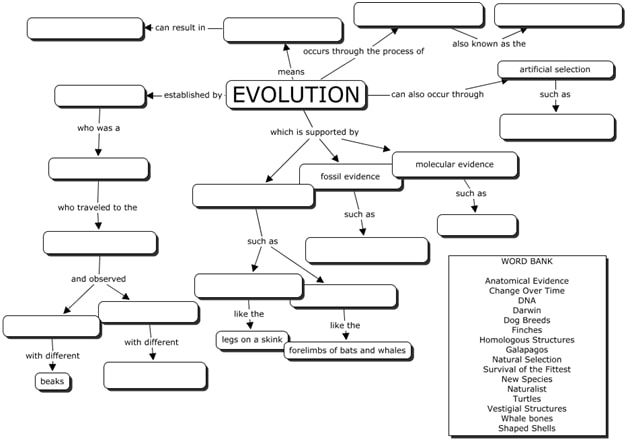Terms in this set (.) pattern of evolution in which species that were once the same have become increasingly different. Divergent evolution. A pattern of evolution in which unrelated species occupy similar environments, and therefore, are subjected to the same selection pressures of the environment, which have caused them to. Mapping biological ideas: Concept maps as knowledge integration tools for evolution education by Beat Adrian Schwendimann A dissertation submitted in partial satisfaction of the requirements for the degree of Doctor of Philosophy in Science and Mathematics Education in the Graduate Division of the University of California, Berkeley Committee in.
Concept Mapping
Download Study Guide Concept Mapping Patterns Of Evolution PDF or Read Study Guide Concept Mapping Patterns Of Evolution PDF on The Most Popular Online PDFLAB. Only Register an Account to DownloadStudy Guide Concept Mapping Patterns Of Evolution PDF. Online PDF Related to Study Guide Concept Mapping Patterns Of Evolution. Get Access Study Guide. 11.6 Patterns in Evolution Speciation often occurs in patterns. A pattern of punctuated equilibrium exists in the fossil record. –theory proposed by Eldredge and Gould in 1972 –episodes of speciation occur suddenly in geologic time –followed by long periods of little evolutionary change –revised Darwin’s idea that species arose.
Basic Strategy
Concept maps are drawings or diagrams used to help students organize and represent knowledge of a subject. Concept maps begin with a main idea (or concept) and then branch out to show how that main idea can be broken down into specific topics.
Why would you use it?
This activity provides an observable action of the student’s patterns of understanding related to a central idea or concept. Concept mapping serves several purposes:
- Helps students brainstorm and generate new ideas
- Encourages students to discover new concepts and the propositions that connect them
- Allows students to more clearly communicate ideas, thoughts and information
- Helps students integrate new concepts with older concepts
- Enables students to gain enhanced knowledge of any topic and evaluate the information
When can you use it?
Concept maps require a lot of cognitive work on the part of the student, and a lot of preparation and analysis on the part of the instructor. Be sure you have tested the concept map activity yourself and given the class the appropriate amount of time to complete the activity. Usually this means twice the amount of time it took you, the expert, to complete. This activity is useful in any course with high theoretical content, courses with large amounts of facts and principles.
How does it work?
- Select the concept/theme you wish students to use as a starting point.
- Create a concept map:
- Identify related key words or phrases. Write down words and key phrases.
- Rank the concepts (key words) from the most abstract/general to the most concrete/specific.
- Cluster concepts that function at similar level of abstraction and those that interrelate closely. Start to determine the ways the various concepts are related to each other and write that on the lines connecting the concepts.
- Arrange concepts into a diagram.
- Continue identifying the ways the various concepts are related to each other and write that on the lines connecting the concepts.
- Add second and third level associations, if appropriate.
- After students have completed the concept maps, present your own example to the students and walk through it with them step-by-step, explaining your thinking as you created the concept map.

Example concept map for diagnoses and treatment
Concept Map Template

Evolution Study Guide Pdf
Important Considerations for Using Concept Maps
- Concept mapping can be a very demanding cognitive task for students.
- Concept maps require a large amount of time and energy from faculty to formally assess; concept maps are generally not graded.
- Large classes may be managed easier if concept map assignments are assigned to small groups.
Other ideas
Concept Mapping Patterns Of Evolution
- Use a top down approach, working from general to specific or use a free association approach by brainstorming nodes and then develop links and relationships.
- Assign a concept map as a small group activity to alleviate anxiety.
- Extend the activity by having students write an explanatory essay based on their maps.
- Construct a concept map and then remove all of the concept labels. Ask students to replace the labels in a way that makes structural sense.
- Create a concept map and then remove concepts from the nodes (about one-third of them). These deleted concepts are placed in a numbered list on the map and students choose among them.
- Provide a list of concept labels (10 to 20) and ask students to construct their maps using only these labels. The focus here is on the linking relationships, and the evolution of structural complexity of students’ knowledge frameworks.
Technology based options

There are numerous software tools where students can create concept maps digitally. A few favorites are:
- Canva https://www.canva.com/graphs/mind-maps/
- Free Mind http://freemind.sourceforge.net/wiki/index.php/
- Mindomo https://www.mindomo.com/